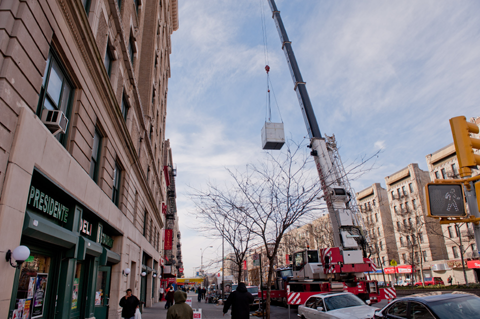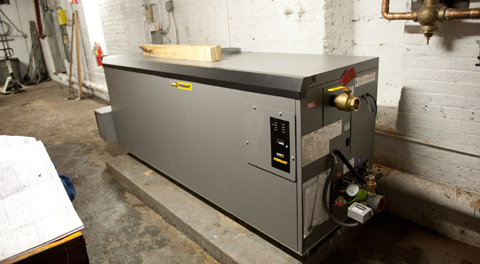Recently at a residential co-op in Upper Manhattan, Rand administered the installation of three new gas absorption chillers and two new boilers that required some tricky maneuvering.
The new 60-ton-capacity chillers (each weighing 5,310 pounds) and boilers (1,025 pounds) are factory built and could not be assembled in place. Instead, each chiller and boiler had to be installed as a complete unit. The problem: The units are too large to pass through the doorways.
The original plan was to open an existing hatch in the sidewalk, but there was gas and sprinkler piping underneath, which couldn’t be moved. So we turned to Plan B: Hoisting the units by a crane, one by one, over the second-floor roof and lowering them into the courtyard.

A crane hoisted the 5,310-pound chiller over the second-floor roof.
But before the chillers and boilers could be hoisted into the courtyard, we had to clear a path for them to get them into the boiler room. That required making a large opening in the rear wall of the boiler room and removing two feet of depth in the courtyard floor to accommodate the height of the chillers so they could pass through the opening.
A telescopic crane parked along Broadway lifted each unit over the sidewalk and into the building. Safety personnel directed pedestrian traffic while the loads were overhead. Each unit took about 45 minutes to rig, lift, and lower into place.
While getting the units into the boiler room took some careful choreography, the maneuvering didn’t end there. To support the weight of the chillers, concrete pads had to be installed for them to rest on. But the pads could not be built before the units were moved into place because space in the boiler room was tight and the pads would have limited the positioning of the units. Therefore, the units were first moved into the room, raised with a power-jack, and the new concrete pads were poured below them. The units were then lowered onto the pads after they hardened.

After it was lowered into the courtyard, the chiller was moved into the boiler room through a hole made in the wall.
After the chillers were in place, the pumps, piping, and controls were installed. The back wall of the boiler room was closed up, and the dug-up portion of the courtyard room was refilled.
To further complicate the installation, gas service to the building was interrupted due to an unrelated incident. The new chillers and boilers operate on gas, and to restore service, new gas piping has to be installed and the system must be pressure tested.

After a painstaking journey, the chiller in its final resting place.
Fortunately most heating plant upgrades Rand administers aren’t as complex as this one, but it was interesting project that called for some creative planning and execution.
